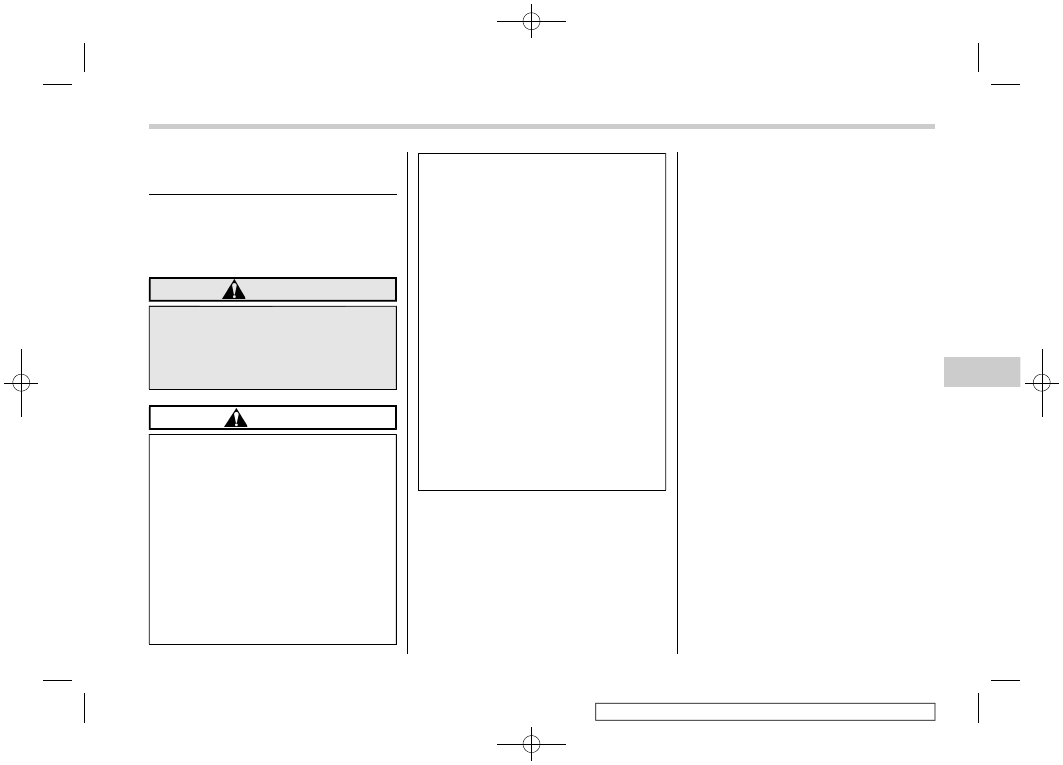Subaru WRX STI (2019 year). Manual - part 18

(289,1)
北米Model "A1720BE-A" EDITED: 2018/ 3/ 9
Continuously variable trans-
mission
The continuously variable transmission is
electronically controlled and provides an
infinite number of forward speeds and 1
reverse speed. It also has a manual mode.
WARNING
Do not shift from the “P” or “N”
position into the “D” or “R” position
while depressing the accelerator
pedal. This may cause the vehicle
to jump forward or backward.
CAUTION
.
Observe the following precau-
tions. Otherwise, the transmis-
sion could be damaged.
– Shift into the “P” or “R” posi-
tion only after the vehicle has
completely stopped.
– Do not shift from the “D”
position into the “R” position
or vice versa until the vehicle
has completely stopped.
.
Do not race the engine for more
than 5 seconds in any position
except the “N” or “P” position
when the brake is applied or
when chocks are used in the
wheels. This may cause the
transmission fluid to overheat.
.
Never move the vehicle as fol-
lows. Doing so may result in an
unexpected accident or malfunc-
tion.
– Moving rearward by inertia
with the select lever set in a
forward driving position.
– Moving forward by inertia with
the select lever set in the “R”
position.
.
When parking the vehicle, first
securely apply the parking brake
and then place the select lever in
the “P” position. Do not park for a
long time with the select lever in
any other position as doing so
could result in a dead battery.
NOTE
.
When the engine coolant tempera-
ture is still low, the transmission will
upshift to higher engine speeds than
when the coolant temperature is suffi-
ciently high in order to shorten the
warm-up time and improve driveability.
The gearshift timing will automatically
shift to the normal timing after the
engine has warmed up.
.
Immediately after transmission fluid
is replaced, you may feel that the
transmission operation is somewhat
unusual. This results from invalidation
of data which the on-board computer
has collected and stored in memory to
allow the transmission to shift at the
most appropriate times for the current
condition of your vehicle. Optimized
shifting will be restored as the vehicle
continues to be driven for a while.
.
When driving under continuous hea-
vy load conditions such as when climb-
ing a long, steep hill, the engine speed
or the vehicle speed may automatically
be reduced. This is not a malfunction.
This phenomenon results from the
engine control function maintaining
the cooling performance of the vehicle.
The engine and vehicle speed will
return to a normal speed when the
engine is able to maintain the optimum
cooling performance after the heavy
load decreases. Take extremely care
when driving under a heavy load.
.
The continuously variable transmis-
sion is a chain type system that pro-
vides superior transmission efficiency
for maximum fuel economy. At times,
depending on varying driving condi-
tions, a chain operating noise may be
– CONTINUED –
Starting and operating/Continuously variable transmission
7-23
7